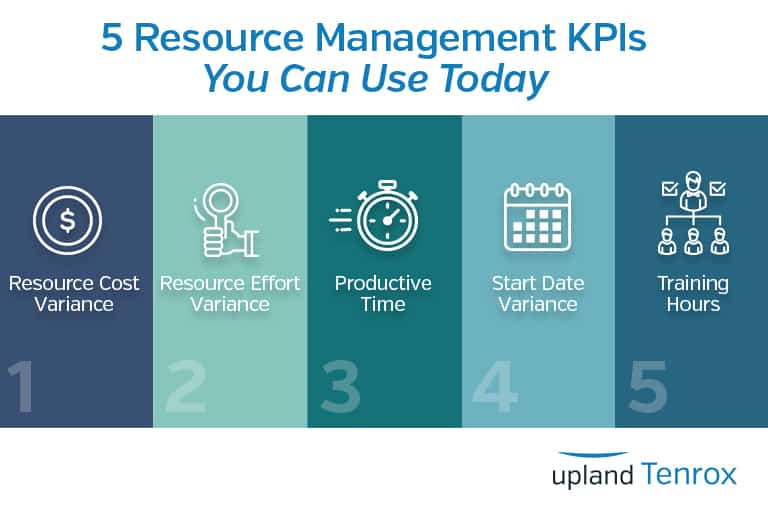Data is so important when it comes to managing your business – or your projects – efficiently. But what should be you tracking for resource management? Can your PSA software track them?
Here are 5 common resource management key performance indicators (KPIs). They provide data points for managers to help with better planning, forecasting and understanding your resource data. Is your business using any of these?
1. Resource Cost Variance
This is a common KPI across PMOs and project teams because it is so helpful. You’re looking at the variance between the forecasted budget for resources and the actual budget. The result is normally expressed as a percentage of the total resource budget.
Good because: Senior managers are usually very interested in the money! This is a good metric to use to talk about project progress as well as resource costs. It’s certainly one to keep front of mind if you bill clients for resource time. If you charge on a fixed price basis, you have to know and manage your resource costs to be sure that you keep your profit margins.
Watch for: Trends. It’s fine to be a bit up on budget if you know you had a busy time, but if the trend is constantly up, you’ll want to reconsider whether you have budgeted adequately for your resource costs.
2. Resource Effort Variance
Similar to cost variance, effort variance looks at the difference between forecasted hours worked and actual hours worked.
The information you’ll get from being close to this metric is helpful in understanding:
- How good your estimating is
- Types of tasks typically take longer than planned
- Types of tasks typically take less time than planned.
As you build up knowledge, you can better plan your resource capacity to avoid bottlenecks in staffing. These metrics give you great analytics to understand your workforce and project performance.
Good because: As we’ve seen, this measure tells you a lot about good estimating, but also about how much progress you are making on a project. The data can give you an early warning that work is taking longer than planned – that can happen for a variety of reasons – so you can take steps to address any scheduling issues.
Watch for: Trends across teams. Generally, we find that some departments are better at estimating than others. If you consistently spot a team where they under- or over-estimate hours, you can support them with more training about estimating.
3. Productive Time
We knew of a project team who had levels of unproductive time topping 20%! That team did a lot of travel, and as they started to collect resource management KPIs, they realized the impact this was having.
The team increased the amount of work that was done remotely, and while the nature of the project meant some travel was still essential, they vastly increased their productivity.
Set a target for productive time – this is particularly relevant to project work. For example, one resource might have a target of 32 hours per week or more. Whatever you choose, you can track
Good because: You can spot teams who have low levels of productivity so you can review their targets and working environment. There could be good reason for the way they are working, so be sure to understand the data before making any judgements.
Watch for: Setting unreasonable targets. No one is going to be productive 100% of their working day because we all need to get up for a stretch and a coffee at some point. And let’s not get started on the amount of “urgent” interruptions that take you away from project work.
Also look out for teams with productive time of over 100%. Some people will think it makes them look better to record that they are working extra hours, but it could be a sign that the data is inaccurate or that they need to better understand why you want the information so they can complete their timesheets more accurately.
4. Start Date Variance
This metric looks at whether or not work started on time. Project work is scheduled with a start date. While it’s common for things to change on a project, it is useful to know whether or not people started work when they said they would.
Measure the planned start date compared to the actual start date and compare the two to get the variance. Late starting tasks often finish late, so this measure can also help you with early warning signs of projects that might struggle to hit their milestones.
Good because: You can identify if there are particular people or teams who have a habit of starting late. There might be an issue with their workload – they could constantly be in crisis mode if they are overloaded, which would account for regular late starting tasks.
Watch for: Creating a blame culture. Don’t assume that the person who always starts a task late is lazy! Maybe they are super efficient at getting their tasks done and the estimate was incorrect in the first place. Or perhaps the person who was working on the task before always hands over their parts late. Data is only one part of the story, so be sure to understand the context too.
5. Training Hours
Let’s not slip into the habit of thinking of resources as simply avatars on a screen or bars in your capacity planning tool. “Resource” is management speak for a person!
Good leaders know that they need to train and develop their teams because that increases staff loyalty and improves project success rates. Tracking training hours per person is one way to make sure that you invest in everyone.
Set some targets for the team. For example, your specialist lawyers might require 3 weeks of training per year. In a healthcare environment, nurses will need to carry out mandatory clinical training. An IT developer might have a target of 60 hours a year of technical learning. When the goals are set, you can track against them.
Good because: What gets measured gets done! Managers and staff will find it hard to come up with excuses for not carrying out training. You can also ensure that all team members get an equal opportunity to take part in professional development.
Watch for: Training targets that only hit mandatory levels. That’s not development; that’s keeping your team compliant with regulation or professional standards. Successful employers will want to go beyond the minimum, but work with your HR team to find an approach that works for your business.
It’s easy to pull out these metrics, and more, when you have the right resource management tools.
Want more practical tips on how to manage uncertainty in resource availability? Has your team grown recently, and your ad hoc processes aren’t as effective any longer? Being able to adequately manage your resources can make all the difference for effective project delivery. Check out these additional resources to learn more:
